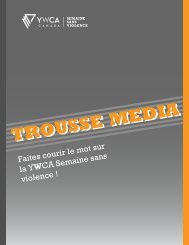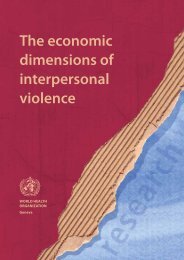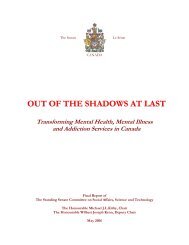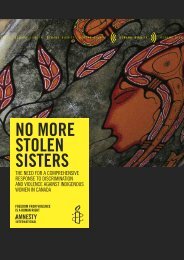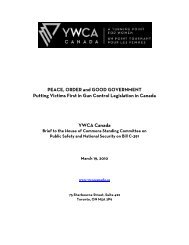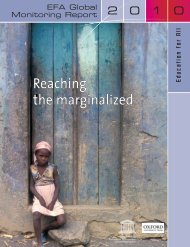Gender Report Card on the International Criminal ... - YWCA Canada
Gender Report Card on the International Criminal ... - YWCA Canada
Gender Report Card on the International Criminal ... - YWCA Canada
Create successful ePaper yourself
Turn your PDF publications into a flip-book with our unique Google optimized e-Paper software.
Judiciary – Key Decisi<strong>on</strong>s Protecti<strong>on</strong> and Protective Measures<br />
those associated with <strong>the</strong> Court’s activities.<br />
Out-of-court protecti<strong>on</strong> measures can include<br />
relocati<strong>on</strong> and placement in a safe house,<br />
support in remaining in <strong>the</strong> locati<strong>on</strong> <strong>the</strong>y reside<br />
in, as well as <strong>the</strong> manner in which victims are<br />
c<strong>on</strong>tacted and questi<strong>on</strong>ed in preparati<strong>on</strong> for<br />
trial. The periodic c<strong>on</strong>siderati<strong>on</strong> of <strong>the</strong> interim<br />
release of an accused, required by <strong>the</strong> Rome<br />
Statute, also raises protecti<strong>on</strong> issues throughout<br />
a trial’s proceedings.<br />
In-court measures<br />
In <strong>the</strong> three trials currently underway, two of<br />
which include charges and <strong>the</strong>refore victims and<br />
witnesses addressing to sexual violence, all <strong>the</strong><br />
Chambers have utilised protective measures.<br />
Protective measures are thus in place to protect<br />
vulnerable witnesses, including witnesses<br />
of sexual violence, to testify with c<strong>on</strong>fidence<br />
in <strong>the</strong>ir physical and psychological safety. 2033<br />
Greater use of in-court protective measures by<br />
<strong>the</strong> ICC reflects <strong>the</strong> judicial exercise of statutory<br />
obligati<strong>on</strong>s outlined in <strong>the</strong> Rules of Procedure<br />
and Evidence of <strong>the</strong> Rome Statute, particularly<br />
Rules 70, 71, 72, 87 and 88, c<strong>on</strong>cerning, inter<br />
alia, in camera hearings and <strong>the</strong> use of special<br />
measures. As noted by Brigid Inder in a<br />
presentati<strong>on</strong> at UNHCHR in May 2011:<br />
This may reflect a change in legal<br />
practice towards more compassi<strong>on</strong>ate<br />
and effective soliciting of testim<strong>on</strong>y; it<br />
may also reflect greater understanding<br />
and legal evoluti<strong>on</strong> in internati<strong>on</strong>al<br />
criminal law regarding issues of<br />
c<strong>on</strong>sent in coercive envir<strong>on</strong>ments<br />
such as armed c<strong>on</strong>flicts, which makes<br />
combative challenges al<strong>on</strong>g <strong>the</strong>se lines<br />
redundant.<br />
2033 ‘Presentati<strong>on</strong> by Brigid Inder to <strong>the</strong> UNHCHR Expert<br />
Meeting <strong>on</strong> <str<strong>on</strong>g>Gender</str<strong>on</strong>g> and Witness and Victim Protecti<strong>on</strong>’,<br />
UN High Commissi<strong>on</strong>er for Human Rights, Geneva, 26-27<br />
May 2011.<br />
Informati<strong>on</strong> from <strong>the</strong> Registry indicates that<br />
as of June 2010, 12 of <strong>the</strong> 15 (80%) Prosecuti<strong>on</strong><br />
witnesses (including expert witnesses) who<br />
have testified in <strong>the</strong> Katanga & Ngudjolo case,<br />
<strong>the</strong> first case to include crimes of gender-based<br />
violence, have benefited from some degree<br />
of in-court protective measures. 2034 Similarly,<br />
according to <strong>the</strong> Internati<strong>on</strong>al Bar Associati<strong>on</strong><br />
(IBA), 22 of 28 witnesses in <strong>the</strong> Lubanga trial<br />
testified subject to protective measures and<br />
ei<strong>the</strong>r partially or entirely in closed sessi<strong>on</strong>. 2035<br />
In fact, <strong>the</strong> extensive use of in camera hearings<br />
resulted in a 2010 Defence request in <strong>the</strong><br />
Katanga & Ngudjolo case that <strong>the</strong> Trial Chamber<br />
review its high use of closed and private sessi<strong>on</strong>s,<br />
and to take steps to mitigate <strong>the</strong>ir effect. 2036<br />
2034 ICC-01/04-01/07-2255.<br />
2035 ‘The ICC’s Trials: An Examinati<strong>on</strong> of Key Judicial<br />
Developments at <strong>the</strong> Internati<strong>on</strong>al <strong>Criminal</strong> Court<br />
between November 2009 and April 2010’, Internati<strong>on</strong>al<br />
Bar Associati<strong>on</strong> ICC Programme <str<strong>on</strong>g>Report</str<strong>on</strong>g>, Internati<strong>on</strong>al<br />
Bar Associati<strong>on</strong>’s Human Rights Institute, May 2010,<br />
p 10, available at , last visited <strong>on</strong> 31 October 2011.<br />
2036 ICC-01/04-01/07-215. For more informati<strong>on</strong> about this<br />
challenge, see <str<strong>on</strong>g>Gender</str<strong>on</strong>g> <str<strong>on</strong>g>Report</str<strong>on</strong>g> <str<strong>on</strong>g>Card</str<strong>on</strong>g> 2010, p 162-163.<br />
315








